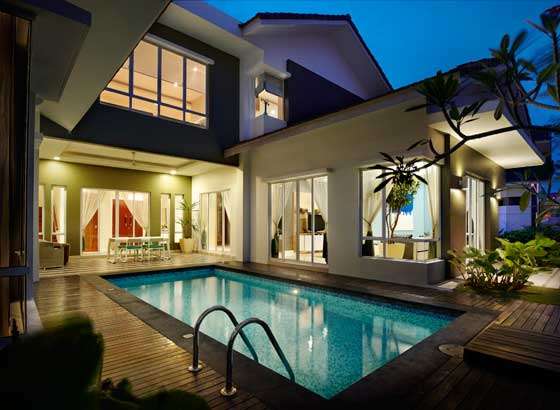Singapore eyes Malaysia for cheaper living
Financial Times, 4 Feb 2013
By Jeremy Grant in Singapore

When Tina Ward, a Singaporean mother of two, and her British husband realised they were outgrowing their cramped, government-built apartment in Singapore, they took a gamble.
Instead of trying to find bigger accommodation in the island city-state, the Wards looked across the Singapore Strait to abandoned palm oil plantations on the southern tip of Peninsular Malaysia where land goes for a fraction of what it does on the Singaporean side of the border.
Now, four years later, the family lives in a seven-bedroom mansion with a swimming pool in a community populated by expatriate escapees from Singapore, which is itself just a 30-minute drive away.
“It’s the best decision we made in our lives,” Mrs Ward says.
The Wards were early settlers in Ledang Heights, part of a huge special economic zone called Iskandar that spans a 2,200 sq km area three times the size of Singapore and roughly the size of Luxembourg.
Iskandar is one of over a dozen big-ticket projects under the Malaysian government’s so-called economic transformation programme, designed to help attract higher-value industries and boost foreign investment in the country.
The progress made so far in redeveloping the palm oil plantation is likely to be highlighted by Najib Razak, the country’s prime minister, ahead of a general election due within two months. The prime minister has boasted of his government’s record in attracting inward investment.
The development of new residential and corporate space will also benefit tiny Singapore, where rising costs are hitting some companies and residents hard. Iskandar, said one consultant, could eventually be for Singapore what New Jersey is to New York’s high-cost Manhattan.
Launched in 2006, Iskandar will become a metropolis of 3m people by 2025, policy makers hope, filled with privately funded industry, hospitals, schools and plenty of parks.
They also see Iskandar as a trade and oil storage hub for the Association of Southeast Asian Nations, whose 10 members – including Indonesia, Thailand and Malaysia – are growing rapidly thanks to increasing intraregional commerce.
Such have been the attractions of relatively cheap land in Iskandar that it has not only pulled in new residents like the Wards, but also M$105bn (US$35bn) in cumulative investments as of the end of last November, according to the Iskandar Regional Development Authority, which oversees the project.
“We’ve reached a tipping point,” says its chief executive, Ismail Ibrahim.
Investors include three British universities – Southampton, Newcastle and Reading – which are building campuses as part of an education hub, and the first Legoland theme park in Asia, which opened four months ago.
Investors have been lured by incentives such as a 10-year corporate tax holiday and in the special zone of Medini the waiver of affirmative action preferences that usually require foreign businesses to join with Malay, or so-called bumiputra, partners.
Yet the real long-term outcome of Iskandar could be closer economic relations between Malaysia and Singapore, which split acrimoniously from its neighbour in 1965.
Faced with a shortage of land and rising business costs, companies in Singapore may come under pressure to consider relocating some functions, consultants say.
Till Vestring, managing director in the southeast Asia practice at consultancy Bain, suggests that Iskandar and Singapore could develop a “twinning” concept similar to that between New York’s Manhattan district and neighbouring New Jersey state.
“An advantage over India or the Philippines is that operations in Iskandar can be supervised easily from Singapore and remain tightly integrated,” he says.
That is the sales pitch being used by Global Capital & Development, a company luring developers to Medini and backed by Mubadala, Abu Dhabi’s sovereign wealth fund, and its Malaysian counterpart, Khazanah.
Keith Martin, chief executive of GC&D, says: “Singapore actually gets a double benefit because its gets the value-added business of having companies headquarter there, but the support space they get in Medini will free up more land in Singapore for more high value-added businesses.”
Critics of Iskandar say that the project has developed in sometimes piecemeal fashion with ambitious announcements that fall short in the execution. Visitors to the site drive along stretches of road flanked with empty land awaiting development.
In addition, local politicians warn that the region’s predominantly Malay population is being economically marginalised by a flood of investment that has inflated property prices.
Nur Jazlan Mohamed is a member of parliament representing the United National Malays Organisation – the dominant party in Mr Najib’s governing Barisan Nasional coalition – in the state of Johor.
He says he has reservations about the project: “Everyone’s suffering as prices are beyond the median incomes of people here. There were a lot of incentives given to foreign investors but there has to be a balance.”
Temasek, Singapore’s state investment agency, and Khazanah in 2011 agreed jointly to develop a residential and commercial property project in Iskandar which both believe will be worth M$3bn on completion.
“Iskandar represents the most concerted effort by both countries to have some sort of loose economic co-operation,” says Eugene Tan, assistant professor of law at Singapore Management University. “It’s still very early days, but it is a window of opportunity for both.”
This article has been amended to reflect that Temasek and Khazanah agreed in 2011 jointly to develop projects in Iskandar which both believe will be valued at M$3bn when completed, not that both will invest S$11bn in the projects as incorrectly stated previously.